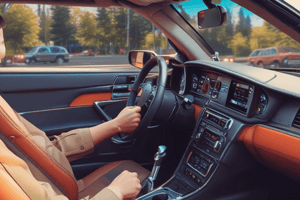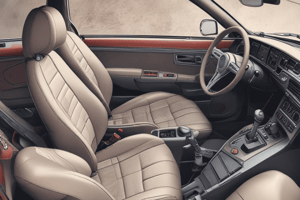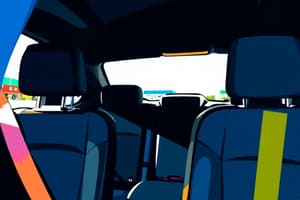Podcast
Questions and Answers
What is the primary function of the information fusion module in the AFLS system?
What is the primary function of the information fusion module in the AFLS system?
- To control the intensity of individual LEDs in headlights.
- To adjust the headlight beam position dynamically.
- To monitor system health and detect issues.
- To integrate data from perception, vehicle, and map modules. (correct)
Which parameters are stored in the configuration/calibration parameters module?
Which parameters are stored in the configuration/calibration parameters module?
- Sensor data and real-time traffic scenarios.
- Vehicle speed and steering angle data.
- Environmental lighting conditions.
- System parameters and calibration data. (correct)
What does the lighting control logic utilize to determine the appropriate headlight beam pattern?
What does the lighting control logic utilize to determine the appropriate headlight beam pattern?
- Fused information considering road and traffic conditions. (correct)
- Traditional lighting techniques without sensors.
- Data exclusively from vehicle speed sensors.
- LED driver commands only.
What is the role of the LED driver module abstraction in the AFLS architecture?
What is the role of the LED driver module abstraction in the AFLS architecture?
How does AFLS primarily differ from ADB in terms of functionality?
How does AFLS primarily differ from ADB in terms of functionality?
Which sensors are optionally included in the typical components of an AFLS system?
Which sensors are optionally included in the typical components of an AFLS system?
What capability does ADB have that AFLS does not?
What capability does ADB have that AFLS does not?
What is the primary function of the Seat Control Module (SCM)?
What is the primary function of the Seat Control Module (SCM)?
What is the primary function of the actuators in an AFLS system?
What is the primary function of the actuators in an AFLS system?
Which of the following standards does TEL adhere to in seat system development?
Which of the following standards does TEL adhere to in seat system development?
What is one of the main functions of a vehicle gateway?
What is one of the main functions of a vehicle gateway?
What is one of the innovative future trends for seat systems mentioned?
What is one of the innovative future trends for seat systems mentioned?
How does TEL aim to enhance efficiency in seat system development?
How does TEL aim to enhance efficiency in seat system development?
Which feature of the gateway allows for wireless updates of ECU software?
Which feature of the gateway allows for wireless updates of ECU software?
What type of microprocessor is within the Seat Control Module (SCM)?
What type of microprocessor is within the Seat Control Module (SCM)?
What does the OPTIGA TPM contribute to the gateway's security?
What does the OPTIGA TPM contribute to the gateway's security?
Which component is responsible for regulating voltage in the seat system?
Which component is responsible for regulating voltage in the seat system?
Which microcontroller is mentioned as a high-performance unit in gateway architecture?
Which microcontroller is mentioned as a high-performance unit in gateway architecture?
What role does the System Basis Chip (SBC) perform in the gateway?
What role does the System Basis Chip (SBC) perform in the gateway?
What feature allows for seat position memory for multiple users?
What feature allows for seat position memory for multiple users?
What is one unique characteristic of off-road capable seats?
What is one unique characteristic of off-road capable seats?
Which of the following is NOT a type of vehicle gateway mentioned?
Which of the following is NOT a type of vehicle gateway mentioned?
What capability allows the gateway to diagnose issues within the vehicle?
What capability allows the gateway to diagnose issues within the vehicle?
Which communication protocols does the gateway's microcontroller support?
Which communication protocols does the gateway's microcontroller support?
What is the primary role of the CAN transceiver in the system?
What is the primary role of the CAN transceiver in the system?
Which component is likely responsible for controlling the reading and interior lights?
Which component is likely responsible for controlling the reading and interior lights?
What is the function of the LITIX™ Power component in the system?
What is the function of the LITIX™ Power component in the system?
How does the PEPS system initiate the engine start?
How does the PEPS system initiate the engine start?
What does the term 'Sunblind' refer to in the context of vehicle control?
What does the term 'Sunblind' refer to in the context of vehicle control?
What is the first step in the operation of the PEPS system?
What is the first step in the operation of the PEPS system?
Which component provides feedback for accurate positioning of the sunroof and sunblind?
Which component provides feedback for accurate positioning of the sunroof and sunblind?
What component is primarily responsible for detecting a user's presence in the PEPS system?
What component is primarily responsible for detecting a user's presence in the PEPS system?
What role does the BCM play in relation to the puddle light?
What role does the BCM play in relation to the puddle light?
Which component is responsible for processing data within the BCM?
Which component is responsible for processing data within the BCM?
What type of communication protocols does the BCM utilize?
What type of communication protocols does the BCM utilize?
How is unauthorized vehicle operation prevented by the ESCL?
How is unauthorized vehicle operation prevented by the ESCL?
What is the function of Hall ICs in the steering lock system?
What is the function of Hall ICs in the steering lock system?
Which component ensures the steering lock is physically engaged?
Which component ensures the steering lock is physically engaged?
What inputs does the BCM primarily receive?
What inputs does the BCM primarily receive?
What is NOT a key component of the BCM?
What is NOT a key component of the BCM?
Flashcards are hidden until you start studying
Study Notes
TEL's Seat System Expertise
- TEL has over 8 years of experience in seat control projects.
- They support 11 car models and 45 variants.
- A dedicated team of 25 members develop and validate seat software.
- They adhere to ISO 26262 and Automotive SPICE standards.
Seat System Development Overview
- They develop seat control systems with both AUTOSAR and non-AUTOSAR architectures.
- They prioritize cost and time reduction through automation and efficient processes.
- They conduct rigorous HILS testing for system validation.
- They provide diagnostic and functionality validation support.
- They support multiple car models and variants.
- They use an agile development approach for rapid prototyping.
Seat Features
- Seats offer various adjustments, including manual and electric adjustments up to 30 ways.
- They feature seat position memory for multiple users.
- They include comfort features like customizable massage, climate control, contour adapting, lumbar support, and side bolstering.
- They provide dynamic support on curves.
- They offer adjustable backrest, headrest, and armrests (both manual and automatic).
- They offer seat absorbers for off-road conditions.
- Seats can swivel up to 360 degrees.
Future Seat Trends
- Stress/fatigue detection and auto-positioning.
- Smartphone connectivity.
- Haptic feedback integrated into seats.
- Lounge seats for autonomous driving vehicles.
- Flexible seats for autonomous driving vehicles.
Seat System Architecture
- Seat Control Module (SCM): The central brain of the system, responsible for coordinating all seat functions and communication.
- 32-bit MCU (AURIX™): The powerful microprocessor within the SCM, handling complex calculations and control algorithms.
- CAN transceiver and LIN transceiver: Communication interfaces connecting the SCM to other vehicle systems and components.
- System Basis Chip (SBC): An additional microcontroller for basic tasks and redundancy.
- Power and Signal Conditioning:
- +12V from battery and +12V switched: Power sources for the system.
- OPTIREG: Voltage regulator for stable power supply.
- Signal conditioning circuits: Process sensor data for accurate interpretation by the MCU.
- Seat Movement and Adjustment:
- NovalithIC™ half-bridges: Power drivers for various seat motors.
TEL's Gateway Development Expertise
- TEL has over 8 years of experience in gateway projects.
- They have supported 4 vehicle programs and 7 variants since 2012.
- They have a team of 20+ members dedicated to gateway development and validation.
- They offer software development, FOTA functionality, security features, diagnostics, validation, ISO 26262 ASIL-C compliance, and hardware prototyping.
Gateway Features
- Protocol Bridging: Translates data between different communication protocols (e.g., CAN, CAN-FD, Ethernet).
- Data Routing: Directs data to the appropriate ECUs within the network.
- Security: Implements security measures to protect vehicle data and prevent unauthorized access.
- Diagnostics: Enables fault detection and diagnosis for troubleshooting.
- FOTA (Firmware Over-the-Air): Facilitates wireless updates of ECU software.
Gateway Types
- CAN-CAN Gateway: Connects multiple CAN networks.
- CAN-CANFD Gateway: Bridges between CAN and CAN-FD networks.
- CANFD-Ethernet Gateway: Connects CAN-FD and Ethernet networks.
Gateway Architecture
- Microcontroller: A high-performance 32-bit AURIX™ MCU serves as the core processing unit, handling data management, communication protocols, and system control.
- Communication Interfaces: Supports multiple communication protocols (CAN, LIN, FlexRay, Ethernet) to connect with different vehicle systems.
- Power Supply: Ensures stable power delivery to the gateway and its components.
- Security: Includes OPTIGA TPM for secure boot, key management, and data protection.
- Central OTA Storage: Provides storage for Over-the-Air (OTA) updates.
- HSM (Hardware Security Module): For cryptographic operations and secure data handling.
- System Basis Chip (SBC): Offers additional functionalities like power management and peripheral interfaces.
Gateway Functionality
- Protocol Bridging: Translates data between different communication protocols.
- Data Routing: Directs data to the appropriate ECUs within the network.
- Security: Protects vehicle data and prevents unauthorized access.
- Diagnostics: Enables fault detection and diagnosis.
- OTA Updates: Facilitates software updates for the gateway and other vehicle components.
Sunroof and Sunblind System Architecture
- Roof Control Module: Receives commands from the driver and sends signals to the NovalithIC™ power half-bridge to control the movement of the sunroof and sunblind.
- Hall Switches: Provide feedback to ensure accurate positioning of the sunroof and sunblind.
- LED Driver: Receives commands from the roof control module to adjust the intensity and colour of the reading and interior lights.
- CAN Bus and LIN Bus: The system communicates with other vehicle systems through the CAN bus and LIN bus, exchanging data and commands.
- Power Management: The LITIX™ Power and LITIX™ Basic components manage the power supply for the entire system.
- Diagnostics: The system includes self-diagnostic capabilities to monitor its own health and report any issues.
PEPS and Door Control System
- Passive Entry Passive Start (PEPS): A keyless entry and start system that allows users to access and operate a vehicle without a physical key.
- Key Components:
- Key Fob/Smartphone: Contains a transponder and a user interface (buttons).
- Sensors: Detect user presence or actions (e.g., touch, proximity).
- RF Antennas: Transmit and receive RF signals.
- RF Receiver: Receives signals from the key fob.
- Start Switch: Initiates engine start.
- Motor Control Unit (MCU): Controls locking/unlocking mechanisms.
- Vehicle Control Unit (VCU): Verifies user authorization and controls engine start.
- Immobilizer: Backup security system.
PEPS and Door System Workflow
-
- The PEPS base station excites the LF Antenna to send an LF signal to the key fob with challenge and RSSI burst.
-
- The key fob responds with key code, signature and location information (RSSI value) to the UHF/BLE receiver ECU.
-
- The UHF/BLE receiver ECU communicates the key code to the PEPS base station ECLI.
-
- The PEPS base station ECU validates the key codes and location, and notifies the BCM.
-
- The BCM communicates with the small light ECU to turn on the puddle light.
-
- The puddle light ECU turns on the puddle light.
-
- The driver touches the door handle.
-
- The door handle ECU in the door senses the touch and notifies the PEPS base station ECU (or BCM).
-
- The PEPS base station ECU validates the key codes and location.
-
- The BCM communicates to the door control ECLI to unlock and open the door.
-
- The door control ECU unlocks the trunk.
PEPS and Door System Architecture
- Microcontroller (MCU): The brain of the BCM, responsible for processing data, making decisions, and controlling outputs.
- Communication: The BCM communicates with other vehicle systems using various protocols like the LIN bus and CAN bus.
- Power Supply: The BCM receives power from the vehicle's battery and distributes it to various components.
- Inputs: The BCM receives inputs from various sensors, switches, and other modules.
- Outputs: The BCM controls various outputs, such as lights, door locks, window lifts, wipers, and other actuators.
Electronic Steering Column Lock (ESCL)
- ESCL: A safety device that prevents unauthorized vehicle operation by mechanically immobilizing the steering column.
- Key Components:
- Steering Lock Actuators:
- Gears, lift, lock bar, steering lock motor: Mechanical components responsible for physically locking and unlocking the steering column.
- Steering lock ECU: Controls the locking and unlocking process.
- Hall ICs, magnet: Sensors for monitoring the position of the lock mechanism.
- Steering column tube: The structural component housing the locking mechanism.
- Electronically Controlled Latch: The mechanism that engages the lock bar with the steering column to prevent its rotation.
- Steering Lock Actuators:
Studying That Suits You
Use AI to generate personalized quizzes and flashcards to suit your learning preferences.




